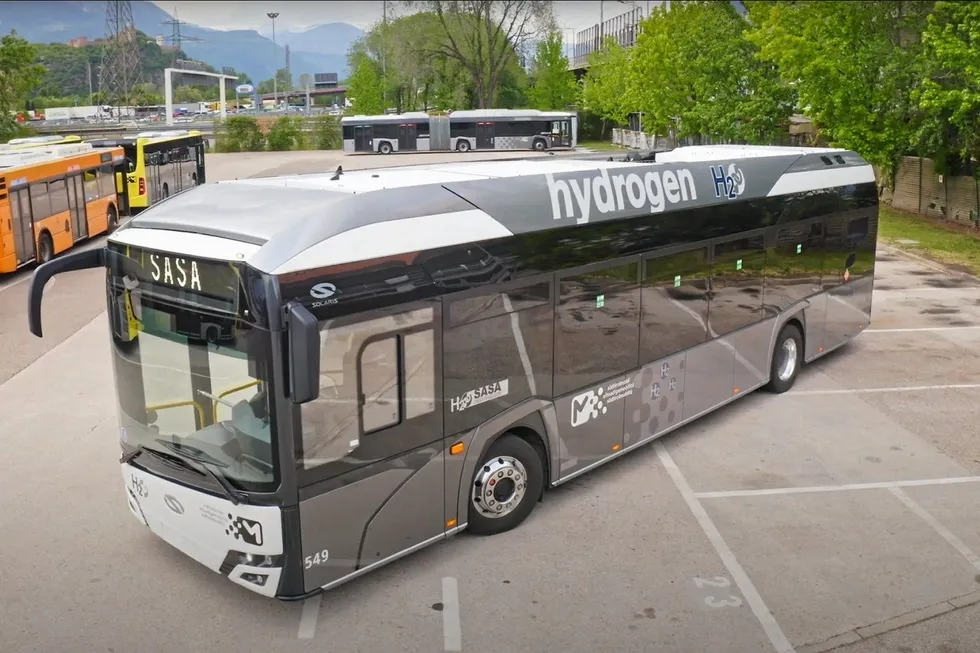A Realistic Look At Hydrogen And Battery-Powered Buses In Europe

Table of Contents
2.1. Battery Electric Buses: The Current Market Leader
Technological Maturity and Infrastructure
Battery electric buses (BEBs) represent the current frontrunner in the green public transport revolution. Technological maturity is high, with several manufacturers offering reliable and efficient models. Many major European cities already boast a growing network of charging infrastructure, facilitating overnight charging at depots and opportunity charging at strategically located terminals. Advancements in battery technology, such as the development of solid-state batteries promising higher energy density and faster charging, further enhance the appeal of BEBs. However, range limitations and charging times remain crucial factors.
- Existing Infrastructure: Cities like Amsterdam, London, and Oslo are leading the way in BEB deployment, supported by significant investments in charging infrastructure.
- Range & Charging: Current BEBs typically have a range of 150-300 km, sufficient for many urban routes, but longer routes may require more frequent charging. Charging times vary, with overnight charging being the most common method.
- Battery Technology Advancements: Solid-state batteries are expected to significantly increase range and reduce charging times, making BEBs even more competitive.
Cost-Effectiveness and Lifecycle Analysis
While the upfront cost of a BEB is higher than a comparable diesel bus, operating costs are significantly lower due to cheaper electricity compared to diesel fuel. Government subsidies and incentives in many European countries further reduce the financial burden on public transport operators. However, a lifecycle analysis must consider battery replacement costs, which can be substantial after several years of operation.
- Upfront Costs: Higher than diesel, but decreasing with economies of scale and technological advancements.
- Operating Costs: Significantly lower than diesel buses due to the lower cost of electricity.
- Government Incentives: Many EU nations offer grants and tax breaks to encourage BEB adoption.
- Battery Lifecycle: Battery lifespan and replacement costs are critical factors in the overall cost-effectiveness of BEBs.
Environmental Impact and Sustainability
BEBs offer a considerably reduced carbon footprint compared to diesel buses, significantly lowering greenhouse gas emissions. However, the environmental impact of battery production and disposal must be carefully considered. The source of electricity used to charge the buses is also crucial; using renewable energy sources is essential to maximize the environmental benefits.
- Reduced Emissions: Significantly lower CO2 emissions compared to diesel buses.
- Battery Production: The mining and processing of raw materials for battery production have environmental implications.
- Battery Recycling: Efficient battery recycling programs are crucial to minimize waste and environmental impact.
- Renewable Energy Sourcing: Using renewable electricity for charging is key to achieving true sustainability.
2.2. Hydrogen Buses: A Promising but Challenging Alternative
Hydrogen Fuel Cell Technology and Infrastructure
Hydrogen fuel cell electric buses (FCEBs) offer zero-tailpipe emissions, converting hydrogen fuel into electricity through a chemical process. However, a major hurdle is the lack of widespread hydrogen refueling infrastructure across Europe. Producing and storing hydrogen also presents significant challenges, although advancements in green hydrogen production (using renewable energy sources like wind and solar) are offering a pathway towards a more sustainable fuel source.
- Fuel Cell Technology: FCEBs use fuel cells to generate electricity, offering similar performance to BEBs but with faster refueling times.
- Hydrogen Infrastructure: A significant lack of hydrogen refueling stations is a major barrier to FCEB adoption.
- Hydrogen Production: Green hydrogen production, powered by renewable energy, is crucial for minimizing the environmental impact.
- Hydrogen Storage: Safe and efficient storage and transportation of hydrogen are ongoing challenges.
Cost Considerations and Economic Viability
The upfront cost of FCEBs is currently higher than BEBs, and the cost of hydrogen fuel is also generally more expensive than electricity. Government support and investment in hydrogen infrastructure are vital to make FCEBs economically viable. Significant economies of scale are needed to reduce the price of both the buses and the hydrogen fuel.
- High Upfront Costs: Currently, FCEBs are significantly more expensive than BEBs.
- Hydrogen Fuel Costs: The price of hydrogen fuel remains a significant barrier to widespread adoption.
- Government Investment: Public funding is crucial for developing hydrogen infrastructure and reducing costs.
Environmental Performance and Sustainability
FCEBs offer zero-tailpipe emissions, making them attractive from an air quality perspective. However, the overall environmental impact depends heavily on the method used to produce hydrogen. Green hydrogen production, utilizing renewable energy, is essential to ensure the sustainability of FCEBs. A comprehensive lifecycle assessment, considering hydrogen production, transportation, and distribution, is crucial for evaluating the true environmental impact.
- Zero Tailpipe Emissions: A major advantage of FCEBs compared to both BEBs and diesel buses.
- Green Hydrogen Crucial: Using renewable energy to produce hydrogen is paramount for minimizing environmental impact.
- Lifecycle Assessment: A thorough analysis considering the entire lifecycle of hydrogen production and use is necessary.
2.3. Comparing Battery and Hydrogen Buses: A Realistic Assessment
Key Differences and Advantages/Disadvantages
| Feature | Battery Electric Bus (BEB) | Hydrogen Fuel Cell Bus (FCEB) |
|---|---|---|
| Upfront Cost | Lower | Higher |
| Operating Cost | Lower | Higher (currently) |
| Refueling Time | Longer (hours) | Shorter (minutes) |
| Range | Moderate (150-300km typically) | Longer (potentially exceeding 400km) |
| Infrastructure | Developing, but growing rapidly | Largely underdeveloped |
| Environmental Impact | Dependent on electricity source | Dependent on hydrogen production method |
Suitability for Different Urban Environments
BEBs are currently better suited for smaller to medium-sized cities with established charging infrastructure. FCEBs, with their longer ranges and faster refueling, could be more advantageous for larger cities or regions with less dense population centers and longer routes, once adequate hydrogen refueling infrastructure is in place.
Future Prospects and Technological Advancements
Both BEB and FCEB technologies are constantly evolving. Advancements in battery technology and the development of green hydrogen production are key to improving cost-effectiveness and environmental performance. The future likely involves a combination of both technologies, tailored to the specific needs of different urban environments and public transport networks.
3. Conclusion: Choosing the Right Path for Green Public Transport in Europe
Both hydrogen and battery-powered buses offer viable pathways towards greener public transport in Europe. BEBs currently hold a market advantage due to their technological maturity and developing infrastructure. However, FCEBs present a promising alternative for longer routes and larger cities once the necessary infrastructure and cost-effectiveness challenges are addressed. A holistic approach, considering infrastructure development, cost-effectiveness, and environmental impact, is crucial. Investing in green public transport requires a strategic blend of both technologies and a commitment to sustainable energy sources. Learn more about sustainable bus solutions in Europe and advocate for the development of the future of hydrogen and battery buses in your community by contacting your local authorities.

Featured Posts
-
 The Young And The Restless Summers Plan To Sabotage Claire And Kyles Apartment
May 07, 2025
The Young And The Restless Summers Plan To Sabotage Claire And Kyles Apartment
May 07, 2025 -
 Iran Sanctions How Us Crackdown Affects Chinese Plastics Industry
May 07, 2025
Iran Sanctions How Us Crackdown Affects Chinese Plastics Industry
May 07, 2025 -
 Alex Ovechkin From Dynamo Moscow Legend To Potential Club Advisor
May 07, 2025
Alex Ovechkin From Dynamo Moscow Legend To Potential Club Advisor
May 07, 2025 -
 Steelers Packers Trade Impact On Josh Jacobs And Green Bays Wide Receiver Corps
May 07, 2025
Steelers Packers Trade Impact On Josh Jacobs And Green Bays Wide Receiver Corps
May 07, 2025 -
 Ryujinx Emulator Project Abandoned Official Statement On Nintendo Contact
May 07, 2025
Ryujinx Emulator Project Abandoned Official Statement On Nintendo Contact
May 07, 2025
Latest Posts
-
 76
May 08, 2025
76
May 08, 2025 -
 2 0 76
May 08, 2025
2 0 76
May 08, 2025 -
 76 2 0
May 08, 2025
76 2 0
May 08, 2025 -
 The Night Inter Milan Beat Barcelona To Reach The Champions League Final
May 08, 2025
The Night Inter Milan Beat Barcelona To Reach The Champions League Final
May 08, 2025 -
 Inters All Time Victory Reaching The Champions League Final By Defeating Barcelona
May 08, 2025
Inters All Time Victory Reaching The Champions League Final By Defeating Barcelona
May 08, 2025
